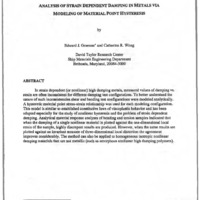-
Title
-
Analysis Of Strain Dependent Damping In Metals Via Modeling Of Material Point Hysteresis
-
Report Number
-
WL-TR-91-3078 Volume III, p. ICC-1 thru ICC-25
-
Creator
-
Graesser, Edward J.
-
Wong, Catherine R.
-
Corporate Author
-
David Taylor Research Center, Ship Materials Engineering Department
-
Date
-
1991
-
Date Issued
-
1991-08
-
Extent
-
25
-
Identifier
-
ADA241313
-
Format
-
1 online resource
-
Abstract
-
In strain dependent ( or nonlinear) high damping metals, measured values of damping vs.
strain are often inconsistent for different damping test configurations. To better understand the
nature of such inconsistencies shear and bending test configurations were modeled analytically.
A hysteretic material point stress-strain relationship was used for each modeling configuration.
This model is similar to established constitutive laws of viscoplastic behavior and has been
adapted especially for the study of nonlinear hysteresis and the problem of strain dependent
damping. Analytical material response analyses of bending and torsion samples indicated that
when the damping of a single nonlinear material is plotted against the one-dimensional local
strain of the sample, highly discrepant results are produced. However, when the same results are
plotted against an invariant measure of three-dimensional local distortion the agreement
improves considerably. The method can also be applied to homogeneous isotropic nonlinear
damping materials that are not metallic (such as amorphous nonlinear high damping polymers).
-
Description
-
In strain dependent ( or nonlinear) high damping metals, measured values of damping vs.
strain are often inconsistent for different damping test configurations. To better understand the
nature of such inconsistencies shear and bending test configurations were modeled analytically.
A hysteretic material point stress-strain relationship was used for each modeling configuration.
This model is similar to established constitutive laws of viscoplastic behavior and has been
adapted especially for the study of nonlinear hysteresis and the problem of strain dependent
damping. Analytical material response analyses of bending and torsion samples indicated that
when the damping of a single nonlinear material is plotted against the one-dimensional local
strain of the sample, highly discrepant results are produced. However, when the same results are
plotted against an invariant measure of three-dimensional local distortion the agreement
improves considerably. The method can also be applied to homogeneous isotropic nonlinear
damping materials that are not metallic (such as amorphous nonlinear high damping polymers).
-
Distribution Classification
-
1
-
Distribution Conflict
-
No
-
DTIC Record Exists
-
No
-
Illinois Tech Related
-
No
-
Photo Quality
-
Not Needed
-
Report Availability
-
Full text available
-
Type
-
article
 artcileICC
artcileICC